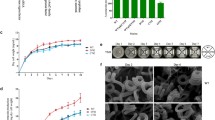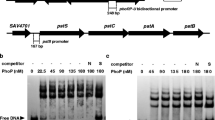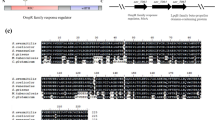Abstract
A transcriptional activator for actinorhodin biosynthesis, AtrA, was previously characterized in Streptomyces coelicolor A3(2), and an orthologue of atrA, named aveI, is identified in the Streptomyces avermitilis NRRL8165 genome (Uguru et al., Mol Microbiol, 58:131–150, 2005). In this study, genetic and functional characterization of aveI gene was reported. Deletion of aveI gene led to increased biosynthesis of avermectin B1a by about 16-fold. The increased synthesis of avermectin B1a was suppressed by complementation with either aveI gene or its orthologue gene atrA from S. coelicolor, suggesting AveI and AtrA shared the similar functionality and were negative regulators for avermectin biosynthesis in S. avermitilis. However, when aveI was introduced into S. coelicolor on a multi-copy plasmid, the production of actinorhodin was significantly increased, indicating that aveI had a positive effect on actinorhodin biosynthesis in S. coelicolor, the same as its orthologue atrA. Electrophoretic mobility shift assays revealed AveI can bind specifically to the promoter region of actII-ORF4 in vitro but not that of aveR. Although its mechanism still needs to be defined, the species-differential regulation by the same regulator may represent an example of the evolutional strategy that enables bacteria to adapt the existing molecular machinery to a variety of functionalities for growth and survival.






Similar content being viewed by others
References
Alper H, Moxley J, Nevoigt E, Fink GR, Stephanopoulos G (2006) Engineering yeast transcription machinery for improved ethanol tolerance and production. Science 314:1565–1568
Burg RW, Miller BM, Baker EE, Birnbaum J, Currie SA, Hartman R, Kong Y-L, Monaghan RL, Olson G, Putter I, Tunac JB, Wallick H, Stapley EO, Oiwa R, Omura S (1979) Avermectins, new family of potent anthelmintic agents: producing organism and fermentation. Antimicrob Agents Chemother 15:361–367
Demain AL (1999) Pharmaceutically active secondary metabolites of microorganisms. Appl Microbiol Biotechnol 52:455–463
Egerton JR, Ostlind DA, Blair LS, Eary CH, Suhayda D, Cifelli S, Riek RF, Campbell WC (1979) Avermectins, new family of potent anthelmintic agents: efficacy of the B1a component. Antimicrob Agents Chemother 15:372–378
Glyn Hobbs CMF, Gardner DCJ, Cullum JA, Oliver SG (1989) Dispersed growth of Streptomyces in liquid culture. Appl Microbiol Biotechnol 31:272–277
Gralla JD, Collado-Vides J (1996) In: Neidhardt FC, Curtis R III, Ingraham JL, Lin ECC, Low KB, Magasanik B et al (eds) Organisation and function of transcription regulatory elements. Escherichia coli and Salmonella: Cellular and Molecular Biology. American Society for Microbiology, Washington, DC, pp 1232–1245
Gust B, Challis GL, Fowler K, Kieser T, Chater KF (2003) PCR-targeted Streptomyces gene replacement identifies a protein domain needed for biosynthesis of the sesquiterpene soil odor geosmin. Proc Natl Acad Sci U S A 100:1541–1546
Hillen W, Berens C (1994) Mechanisms underlying expression of Tn10 encoded tetracycline resistance. Annu Rev Microbiol 48:345–369
Hodgson DA (2000) Primary metabolism and its control in streptomycetes: a most unusual group of bacteria. Adv Microb Physiol 42:47–238
Horinouchi S, Beppu T (1994) A-factor as a microbial hormone that controls cellular-differentiation and secondary metabolism in Streptomyces griseus. Mol Microbiol 12:859–864
Ikeda H, Nonomiya T, Usami M, Ohta T, Omura S (1999) Organization of the biosynthetic gene cluster for the polyketide anthelmintic macrolide avermectin in Streptomyces avermitilis. Proc Natl Acad Sci U S A 96:9509–9514
Im JH, Kim MG, Kim ES (2007) Comparative transcriptome analysis for avermectin overproduction via Streptomyces avermitilis microarray system. J Microbiol Biotechnol 17:534–538
Jobling MG, Holmes RK (1997) Characterization of hapR, a positive regulator of the Vibrio cholerae HA protease gene hap, and its identification as a functional homologue of the Vibrio harveyi luxR gene. Mol Microbiol 26:1023–1034
Khosla C, Gokhale RS, Jacobsen JR, Cane DE (1999) Tolerance and specificity of polyketide synthases. Annu Rev Biochem 68:219–253
Kieser TBM, Buttner MJ, Chater KF, Hopwood DA (2000) Practical Streptomyces Genetics. The John Innes Foundation, Norwich
Kovacikova G, Skorupski K (2002) Regulation of virulence gene expression in Vibrio cholerae by quorum sensing: HapR functions at the aphA promoter. Mol Microbiol 46:1135–1147
Lu YH, Wang WH, Shu D, Zhang WW, Chen L, Qin ZJ, Yang S, Jiang WH (2007) Characterization of a novel two-component regulatory system involved in the regulation of both actinorhodin and a type I polyketide in Streptomyces coelicolor. Appl Microbiol Biotechnol 77:625–635
Madan Babu M, Teichmann SA (2003) Functional determinants of transcription factors in Escherichia coli: protein families and binding sites. Trends Genet 19:75–79
Marvaud JC, Eisel U, Binz T, Niemann H, Popoff MR (1998) TetR is a positive regulator of the tetanus toxin gene in Clostridium tetani and is homologous to BotR. Infect Immun 66:5698–5702
McAdams HH, Srinivasan B, Arkin AP (2004) The evolution of genetic regulatory systems in bacteria. Nat Rev Genet 5:169–178
Miller TW, Chaiet L, Cole DJ, Cole LJ, Flor JE, Goegelman RT, Gullo VP, Joshua H, Kempf AJ, Krellwitz WR, Monaghan RL, Ormond RE, Wilson KE, Albers-Schonberg G, Putter I (1979) Avermectins, new family of potent anthelmintic agents: isolation and chromatographic properties. Antimicrob Agents Chemother 15:368–371
Nevoigt E, Fischer C, Mucha O, Matthaus F, Stahl U, Stephanopoulos G (2007) Engineering promoter regulation. Biotechnol Bioeng 96:550–558
Omura S, Ikeda H, Ishikawa J, Hanamoto A, Takahashi C, Shinose M, Takahashi Y, Horikawa H, Nakazawa H, Osonoe T, Kikuchi H, Shiba T, Sakaki Y, Hattori M (2001) Genome sequence of an industrial microorganism Streptomyces avermitilis: Deducing the ability of producing secondary metabolites. Proc Natl Acad Sci U S A 98:12215–12220
Porath J, Carlsson J, Olsson I, Belfrage G (1975) Metal chelate affinity chromatography, a new approach to protein fractionation. Nature 258(5536):598–599
Retzlaff L, Distler J (1995) The regulator of streptomycin gene-expression, StrR, of Streptomyces griseus is a DNA-binding activator protein with multiple recognition sites. Mol Microbiol 18:151–162
Stephanopoulos G (2007) Challenges in engineering microbes for biofuels production. Science 315:801–804
Studier FW, Rosenberg AH, Dunn JJ, Dubendorff JW (1990) Use of T na-polymerase to direct expression of cloned genes. Methods Enzymol 185:60–89
Thompson CJWJ, Hopwood DA (1980) DNA cloning in Streptomyces: resistance genes from antibiotic-producing species. Nature 286:525–527
Uguru GC, Stephens KE, Stead JA, Towle JE, Baumberg S, McDowall KJ (2005) Transcriptional activation of the pathway-specific regulator of the actinorhodin biosynthetic genes in Streptomyces coelicolor. Mol Microbiol 58:131–150
Xiong W, Liang YX, Zheng YH (2006) Enhancement and selective production of oligomycin through inactivation of avermectin’s starter unit in Streptomyces avermitilis. Biotechnol Lett 28:911–916
Yoon YJ, Kim ES, Hwang YS, Choi CY (2004) Avermectin: biochemical and molecular basis of its biosynthesis and regulation. Appl Microbiol Biotechnol 63:626–634
Acknowledgements
We thank Haiyang Xia for offering the genomic library of S. avermitilis NRRL8165 and Zhejiang Shenghua Biok Biological (China) for offering the medium components for avermectin fermentation. This work was supported by National Natural Science Foundation of China (30770023), the Knowledge Innovation Program of the Chinese Academy of Sciences, KSCX2-SW-329-3, KSCX2-YW-G-007, and National Basic Research Program of China (2007CB707803).
Author information
Authors and Affiliations
Corresponding author
Rights and permissions
About this article
Cite this article
Chen, L., Lu, Y., Chen, J. et al. Characterization of a negative regulator AveI for avermectin biosynthesis in Streptomyces avermitilis NRRL8165. Appl Microbiol Biotechnol 80, 277–286 (2008). https://doi.org/10.1007/s00253-008-1545-8
Received:
Revised:
Accepted:
Published:
Issue Date:
DOI: https://doi.org/10.1007/s00253-008-1545-8




